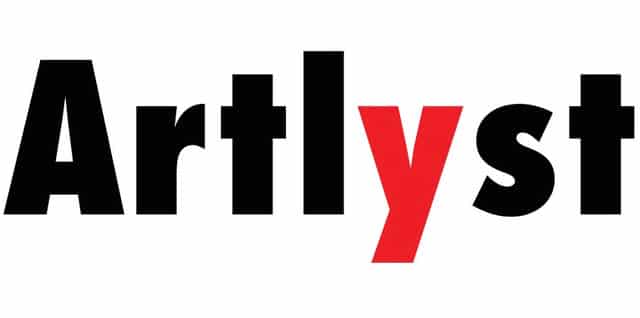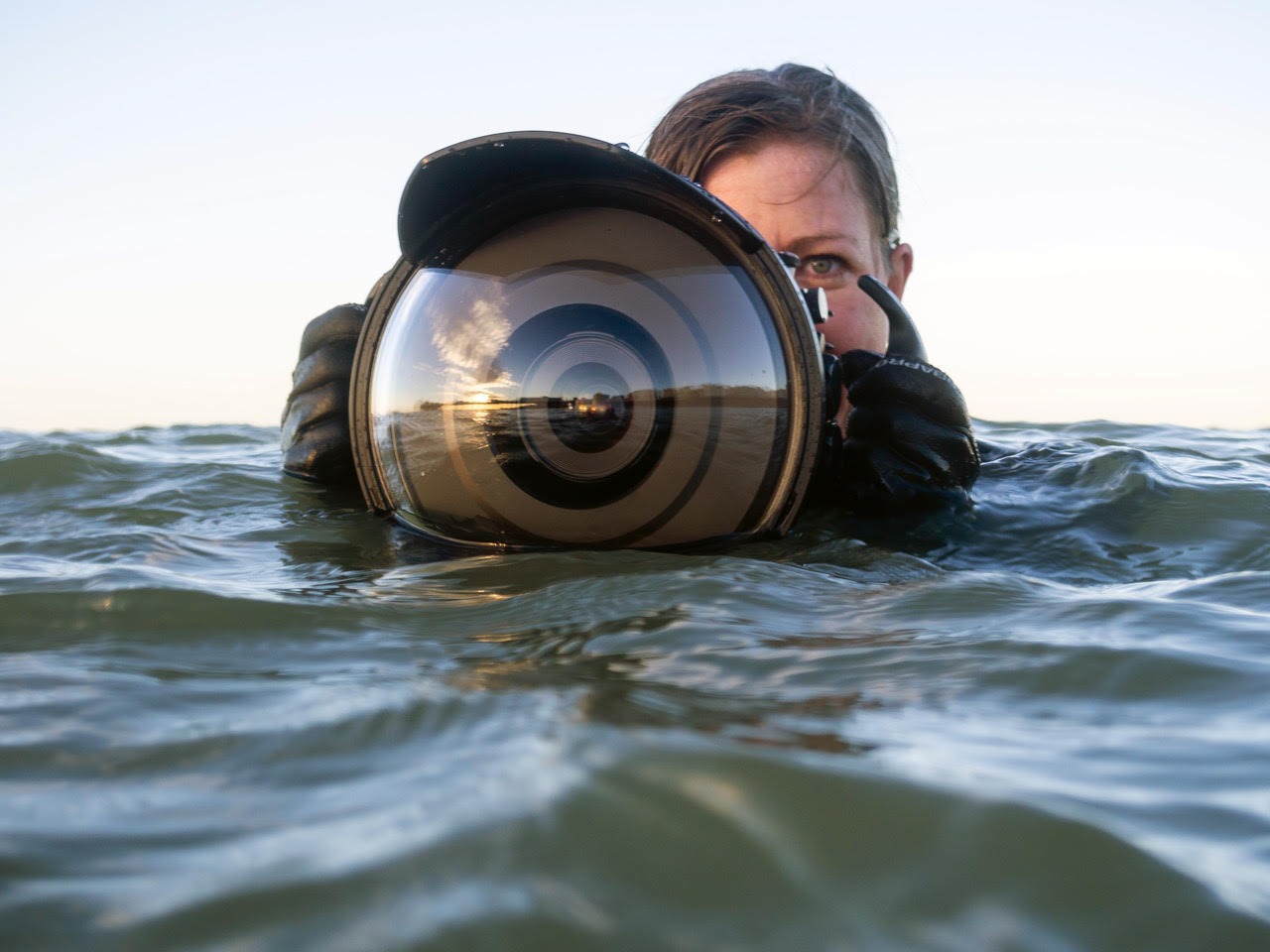For two decades, Emma Critchley’s subject has been the underwater world: she describes herself as ‘an artist who uses a combination of photography, film, sound and installation to continually explore the human relationship with the underwater environment as a political, philosophical and environmental space’. Her current show at Tate St Ives focuses on deep sea mining for rare-earth materials through four means: the fifty minute three-screen film ‘Soundings’, that offers a kaleidoscopic portrayal of the deep ocean as a site of ecological, cultural and geopolitical significance; dance performances that take place regularly in front of the film; transcriptions of a debate on deep sea mining; and an open letter of some 2,500 words co-authored by marine scientists, legal scholars and Indigenous activists proposing what the ‘Rights of the Deep’ should be – available for viewers to take as a booklet.
PCK: Your work deals with the underwater world. How did that come about?
EC: I started diving when I went travelling before going to university. I liked it so much that I spent a year working on dive boats to earn my keep and enable me to dive. I then studied photography at Brighton University, and in the summer, I signed up for a marine conservation project in Indonesia, where we were diving three times a day for six days a week. That started me taking photographs underwater. I got hooked on being in that space and how everything completely changes when you’re in water – your relationship to space, to each other, to light, sound, touch, smell – there’s a complete shift from the land-based way of being. And as I was with people, I ended up photographing them a lot underwater. That led me to think about how we can reflect on ourselves and what happens to us in that space… And that has run throughout my practice, even as that has morphed into thinking about environmental questions.
What should artists be doing in relation to the environment?
There’s so much bad news about what’s happening with climate change – and it is really alarming – that art has a role in helping us think more about how we see ourselves in relation to it. Can we tell alternative narratives, other perspectives? Art can offer up a space to think differently…

Emma Critchley, Soundings, film still, 2024 (footage courtesy of The National Oceanography Centre and the Trustees of the Natural History Museum, with acknowledgement to the NERC SMARTEX project.)
That said, ‘Soundings’ does also call for action to protect the deep from mining?
I made my first film about deep-sea mining in 2016. That was about raising the issue, but hardly anyone picked up on it, perhaps it was too early. Even now it is shining a light on something few people know about. ‘Soundings’ is more about finding relationship with the space. As humans we need to see or touch or have an encounter with something in order to care about it – so how can we find a connection with the deep ocean and its inhabitants, when this space has been sold to us as remote for a long time?

Emma Critchley, Soundings, Live Performance, John Hansard Gallery, 2025. Courtesy the artist. Photograph by Nosa Malcolm
Across its 50 minutes, ‘Soundings’ combines several strands: footage of deep-sea creatures, dancers moving in water, folk traditions connected with the sea, and the proceedings of the International Seabed Authority. If we can consider those in turn, what were you aiming at in showing the creatures?
I wanted to give them time and space in a different way to what you might see in a documentary programme, especially through the encounters with dancers, who are choreographed alongside a Siphonophore and a Dumbo octopus (as illustrated above). We spoke with scientists and learned how little we know about them – our only encounters are when they happen to pass fleetingly through the beam light of a submersible. Trying to treat them as equals, as our kin, to engage with them – we developed a choreography that learned from their movements. Siphonophores are incredible! They are colonies made up from many separate individuals that can only exist together – a perfectly functioning collective feeding into the choreography. One siphonophore is the longest creature in the world, but they vary fantastically.

Emma Critchley, Soundings, Installation view, John Hansard Gallery, 2025. Courtesy the artist. Photo: Reece Straw
Why introduce the underwater dancers?
In a way they are dream sequences: I’m thinking about the fact that we came from the water, so it’s a space we deeply know but have become estranged from. We meet these people under water, and to start with they are trying to be their terrestrial selves. Later in the film, the water informs their movements more. It’s a place we’ve come from, part of our collective subconscious memory.
I wanted to use dance and drawing in the film to explore how we might think with and through the body; ways of being that are less cerebral and perhaps enable us to be more sensitive to nature’s needs.
And they hold their breath impressively underwater?
Yes, even though they hadn’t worked in water before – the dancers had training from a free diver friend of mine on the first day, then we spent a week in the pool together, then two days filming. They were brilliant. The lighting follows from how the deep-sea scenes were lit, providing an apparent continuity. I was lucky with this footage, as I happened to contact the scientists whilst they were on a cruise doing deep-sea mining impact surveys, and they were experimenting with this unusual lighting. The dancers are in a tank – and that is relevant, as we and sea creatures can never be in same space. Above ground, deep-sea specimens are just like frog spawn in a jar – and we’d be crushed by pressure, never mind drowned. So the tank suggests a window onto another world that we can’t enter.

Emma Critchley, Soundings, Installation view, John Hansard Gallery, 2025. Courtesy the artist. Photo: Reece Straw
You also explore folk traditions connected with the sea?
I was thinking about how the story that we’ve come from the ocean and need to protect it is nothing new – it has been around the world forever. So I draw attention to that through song and narrative from Scotland and Indonesia – in a similar way to the dancers in the tank, reminding us of where we come from.

Emma Critchley, Soundings, Installation view, John Hansard Gallery, 2025. Courtesy the artist. Photo: Reece Straw
How did you decide what to use from the conference on deep-sea mining policy?
The International Seabed Authority livestreams their conferences. I wanted to relate the narratives going on and the reality of these meetings: to put this deep sea with its incredible ecosystems that is the foundation of life up against the technocratic debate going on in. Lots of people are trying to do good work to protect the deep, but you also hear from those who simply see it as the next extractive frontier. There could have been far more of the debate, but I wanted to keep a balance in the film, to give a flavour of the discussions alongside providing the chance to read the full transcript.
Visitors can also pick up copies of the booklet ‘The Rights of the Deep’? How did that come about?
Originally, I was just going to interview people – and we do hear voice of a Hawaiian elder whose words in the film came from those conversations – but then I realised that there was nothing setting out the rights of nature in the deep in the way there is for the land, and it became a separate commission. But it is important that visitors can read it in the gallery or here.
When did you last dive?
Too long ago, what with Covid, a daughter who is now five, and working with archive material – it is on my list to get back to it soon! And I will be in the water for my next commission, working with the dancers again.
Top Photo: Emma Critchley – photo Kevin Meredith
Emma Critchley: Soundings runs to 5 Oct at Tate St Ives. It is presented in cooperation with John Hansard Gallery, Southampton (where it showed previously), Tate St Ives and Quay Arts, Isle of Wight (where a version will be presented 10 Oct – 19 Dec). You can, incidentally, read my review of the show in the current issue of Art Monthly.


